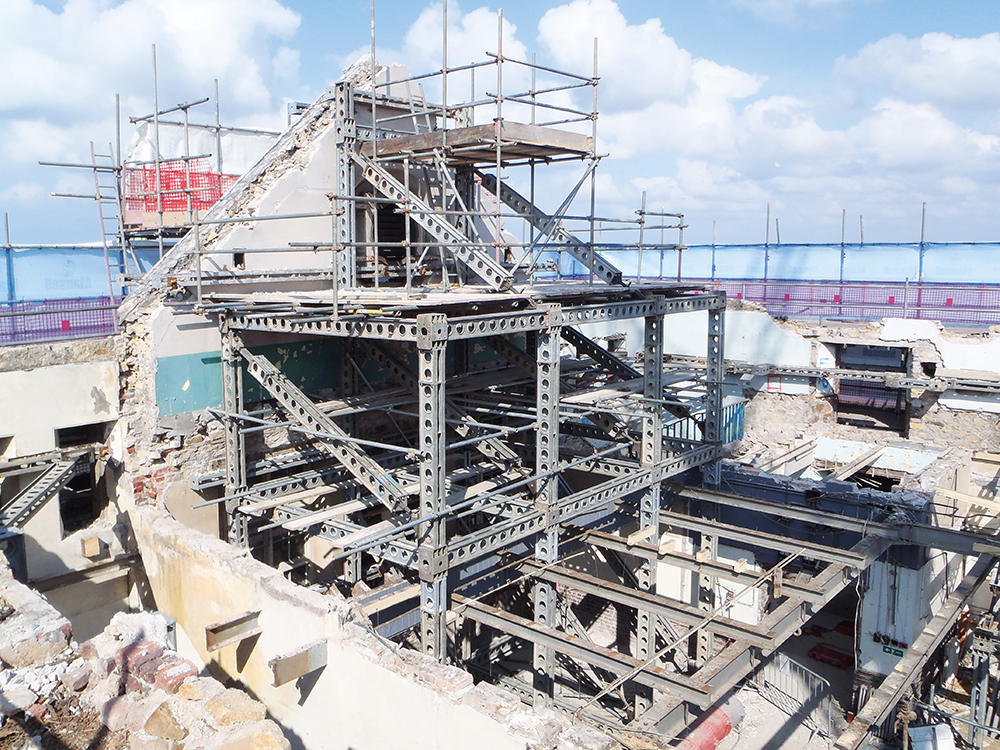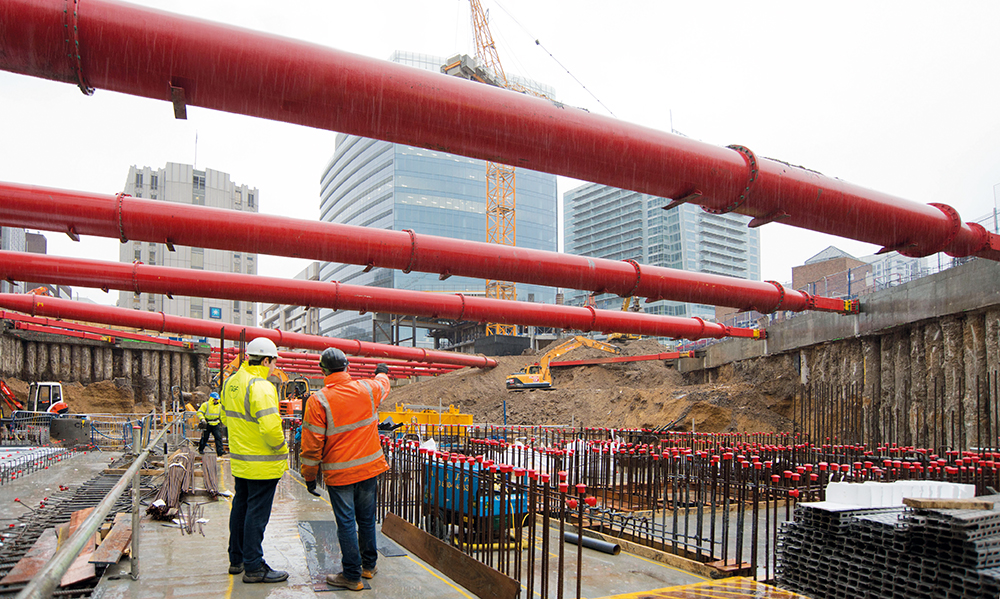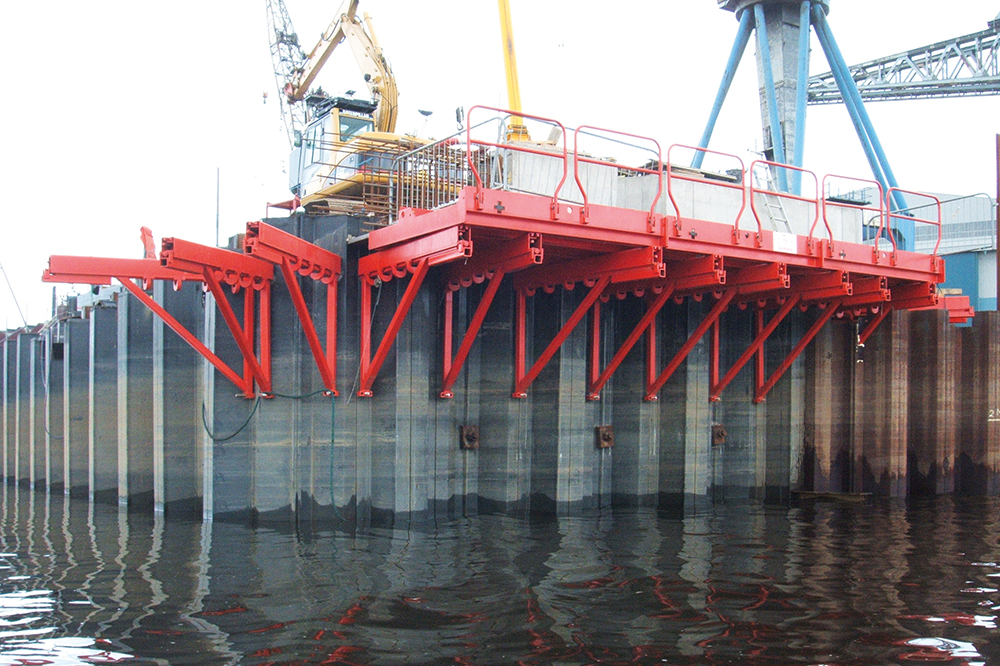
In the first of a new series of CPD articles, David Thomas takes us through temporary works: who is responsible for what?
Temporary works are not purely something that a contractor must address. Permanent and temporary works designers must communicate to ensure that structures and buildings can be constructed safely.
This is not a new message. Nearly 50 years ago, the Bragg Report on falsework, commissioned by the government in 1973 and published in 1976, was saying just that. Here’s an extract:
“It is obviously essential that good communications are established as quickly as possible between the designers of the permanent works and those designing the temporary works. This will ensure that time is not wasted in devising a method of construction that is subsequently found unacceptable.”
Bragg’s observations could be summed up in the ‘3Ps’ – people, process and product.
Although the contractor, through the contract, is responsible for the construction itself, the role of the permanent works designer is vital – as is the role of the contractor’s temporary works coordinator and the principal designer (PD), who should be playing a central role.
What are temporary works?
In simple terms, temporary works can be said to be those parts of a construction project that are needed to enable the permanent works to be built.
BS 5975: 2019, Code of practice for temporary works procedures and the permissible stress design of falsework (2019), is the nationally accepted standard for the procedural control to be applied to all aspects of temporary works. It represents ‘contemporary good practice’.
“Where there is more than one principal contractor’s temporary works coordinator, the boundaries should be recorded in writing.”
The code of practice does not contain a concise definition of temporary works, but states that it can be described as providing an ‘engineered solution’ that is used to support or protect either an existing structure or the permanent works during construction (Clause 5.1.1.1).
The management of temporary works to BS 5975
BS 5975: 2019 gives recommendations and guidance on the procedural controls to be applied to all aspects of temporary works in the construction industry. It provides three fundamental principles for controlling temporary works (Clause 5.1.1.10):
- All organisations have a duty to manage and control their work – and not just contractors. A senior person should be appointed, defined by the term ‘designated individual’, who should be appointed to prepare and manage the organisation’s procedures.
- The contractor is responsible for building the permanent works, and that includes any associated temporary works needed to construct the project.
- One person should take overall responsibility for managing the temporary works – the temporary works coordinator. First established in the Bragg Report, they should be appointed by the principal contractor (PC) and are referred to as the PC’s temporary works coordinator.
Control measures
BS 5975: 2019 also gives a very useful summary of the control measures that should be used to ensure safety for all temporary works (Clause 5.1.2), summarised in the following paragraphs:
Every organisation that has an involvement with temporary works should appoint a senior person to prepare, maintain and implement the organisation’s procedure for the control of temporary works – known as the designated individual. The PC’s designated individual should appoint a temporary works coordinator (the PC’s temporary works coordinator), responsible for all temporary works on the project.

There are additional recommendations, depending on the size of project. For example, on large or complex sites, there may be more than one PC’s temporary works coordinator. In this case, each PC’s temporary works coordinator should be responsible for a distinct, well-defined area of work. Where there is more than one PC’s temporary works coordinator and/or temporary works coordinator, the limits of responsibility, interfaces and boundaries should be recorded in writing.
Any subcontractor to the PC or another contractor – for instance, one working directly for the client – who is contracted to manage their own temporary works and who is working within a PC’s temporary works coordinator’s area of responsibility, should appoint a temporary works coordinator. Note that this temporary works coordinator, who should be appointed by the contracted organisation’s designated individual, should report to the relevant PC’s temporary works coordinator for the area in which they operate.
The PC’s temporary works coordinator and the temporary works coordinator should have the same level of management training. Their technical and practical knowledge should be commensurate with the complexity of the work. Where required, the PC and contractor may appoint temporary works supervisors who report to their temporary works coordinator.
“Permanent works designers should identify and make provision for any temporary works and temporary conditions required for their design.”
Except for very low-risk temporary works, a design brief should be prepared for the temporary works by the site team and issued by the temporary works coordinator to the temporary works designer. Where the category of design check has not been specified, the temporary works designer, in consultation with the relevant temporary works coordinator, should confirm the category and prepare the necessary design output.
The temporary works design checker should carry out the design check of the temporary works, and in certain categories without reference to the temporary works designer’s calculations, before issuing a certificate confirming the design is satisfactory.
Once the site team has constructed the temporary works in accordance with the certified design, the temporary works coordinator or temporary works supervisor, as appropriate, should issue a permit to proceed, confirming the temporary works have been erected in accordance with the certified design and any agreed revisions.
Classifying risks
BS 5975: 2019 (Clause 6.1.3) recommends that the implementation risk for each item of temporary works should be classified. The implementation risk comes from combining the execution risks, associated with workmanship, materials and experience, with the consequence of failure risks – where the temporary works are and what could be affected if they fail.
The classifications should be taken from BS 5975: 2019, Table 1, which sets out the class of implementation risk – very low, low, medium or high – along with the permits required and other control measures needed. Note that mitigation of risks associated with design should be addressed through the category of design check (Clause 13.7) which should not be confused with the implementation risk.
Construction (Design and Management) Regulations 2015
HSE guidance on the CDM 2015 regulations states: “When preparing or modifying designs, a designer must take account of the general principles of prevention, and the pre-construction information provided to them, with the aim, as far as reasonably practicable, of eliminating foreseeable risks.
Useful websites
Collaborative Reporting for Safer Structures (CROSS): www.cross-safety.org/uk
Health and Safety Executive (HSE): www.hse.gov.uk/construction/faq-temporary-works.htm
Temporary Works Forum (TWf): www.twforum.org.uk/home
“Where this is not possible, they must take reasonably practicable steps to reduce the risks or control them through the design process and provide information about the remaining risks to other dutyholders.”
Despite this, there has been – and continues to be – much discussion over many years on this aspect of legislation. Bookcases groan under the weight of published tomes of guidance, yet there is still no consensus on design risk management.
A recent survey on design risk management within the Temporary Works Forum (TWf), 25 years after CDM was first introduced, identified findings that are deeply concerning. Shortcomings and barriers include a lack of constructability knowledge among many permanent works designers, fee-driven constraints, perceived liabilities, lack of
leadership and a conflict between contract and statute over the manner of project management.
The role of the principal designer should be central to successful design risk management, but it seems that many PDs are failing in their responsibilities, according to TWf members.
As part of a 2021 survey commissioned by the HSE to broaden understanding of the CDM 2015 principal designer role, answers from TWf members reported that they had not noted any improvement in the management of temporary works since the introduction of the PD role – which is seen as a failed role like the planning supervisor and CDM coordinator before them.

TWf members also reported that few PDs are involved actively with temporary works designers. Many are “detached” and “one step removed”. However, there are some indications that on larger jobs with “intelligent clients” the role is discharged more effectively, demonstrating the influence of the client.
BS 5975: 2019 reminds dutyholders that permanent works designers should address the buildability of the permanent works and identify and make provision for any temporary works and temporary conditions required by their design and their assumed method of construction.
This should include a proposed method and sequence of construction which should have no adverse effects on the permanent works (Clause 8.3.1).
Design risk management is a means by which designers can demonstrate that their designs can be built, used, maintained and eventually demolished without negatively affecting the safety, health and wellbeing of those involved in the construction process or those who may be impacted by the structure. There is useful guidance on design risk management (see box, p23) which applies equally to temporary works designers and permanent works designers. l
David Thomas is director and secretary of the Temporary Works Forum (TWf).
Useful guidance on temporary works
A selection of useful best practice guides and templates for managing temporary works
From the Temporary Works Forum:
- Principles for the management of temporary loads, temporary conditions and temporary works during the construction process. This guide explains how many failures occur because it is assumed that structures, excavations, stockpiles and other features on construction sites will stand up on their own, at every stage of construction, when in fact they won’t and engineering analysis is needed to back up such judgements.
- TWf Information Sheet No 6, The safe management of temporary works. This sheet provides advice on how to manage temporary works safely. It is aimed at those managing temporary works in small and medium-sized enterprises (SMEs) and is based around CDM 2015 and advice from BS 5975: 2019.
- Temporary Works Procedure: Sample. This free-to-download template is intended as guidance for small-to-medium-sized contractors which are managing small projects that involve them in temporary works. The sample aims to ensure that the main elements of BS 5975: 2019 have been addressed. It does not set out to be prescriptive and should be amended to suit individual company operations and preferences.
- Constructability: A guide to reducing temporary works. The aim of this guide is to raise awareness of the importance of ‘constructability’ to clients, architects, permanent works designers, temporary works designers and contractors. Constructability is an iterative process and should be reviewed at stages throughout the design. The guide includes examples of projects where the benefits of this approach have been achieved.
From the Institution for Civil Engineers (ICE):
- Guidance for design risk management. This is a guide to a risk-based management process for design which covers issues including competency, clarity of responsibility, supervision and review. It is the ICE’s view on what designers need to do to discharge their duties under the CDM 2015 regulations and should also be useful for principal designers, contractors and clients too.
- Designing a Safer Built Environment: A complete guide to the management of design risk. Published in 2021, and written by design risk management consultant John Carpenter, this book aims to address “long-standing uncertainties and challenges faced by designers, highlighted by recent events such as the Grenfell Tower fire”. It is well worth a read, particularly in relation to the consideration of soft hazards.
Further reading
- TWf Yearbook 2021/2022
- TWf Information Sheet No 12, Competence of the Designated Individual (DI)
- TWf Information Sheet No 13, PAS 91, Construction prequalification questionnaires – Supplementary questions specific to temporary works
- Setting the bar: A new competence regime for building a safer future, Construction Industry Council (CIC)
- In plain sight: Assuring the whole-life safety of infrastructure, ICE (2018)
- Look out for the forthcoming APS Practice Note on Temporary Works






